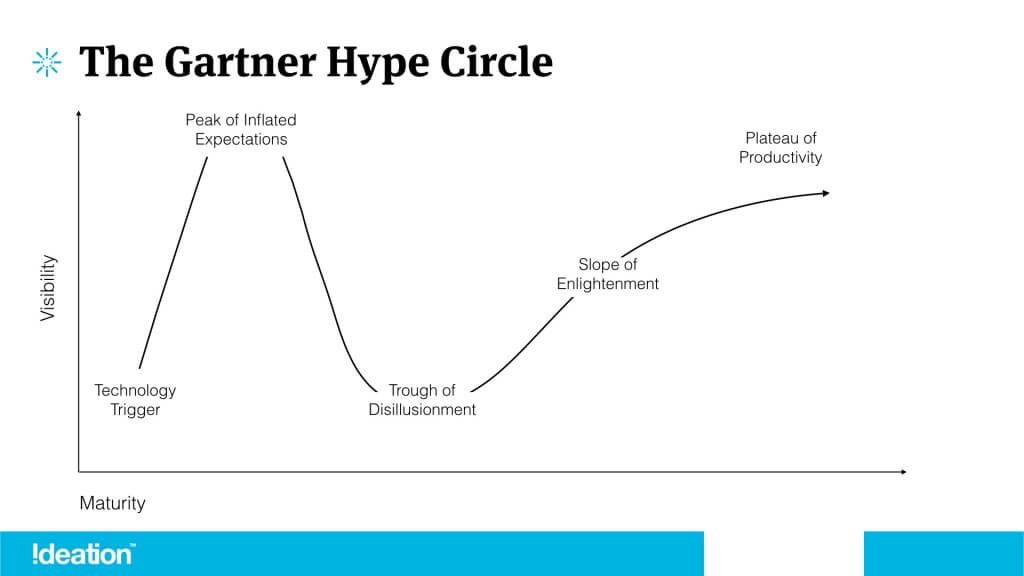Most ideas are filled with hype.
Understandably so, good ideas are designed to take us beyond where we are to where we could be (which is usually a much better place).
Now the challenge…
Choosing to engage or not engage a “good idea” is something we all have to make a decision on quite regularly. There are so many ideas and so many factors that drive their success. How do you manage risk? A lot of this really has to do with our understanding of where the idea sits in its hype cycle.
There’s a helpful graph called the “Gartner Hype Cycle” that was originally designed to describe the cycle that technology ideas go through into order to move from an idea to deployment into the market. In my opinion, the descriptions and key moments in this cycle also provide helpful insights into other industries that seek to navigate idea implementation.

As described by Gartner, the Hype Cycle drills down into the 5 key phases of a technology’s life cycle:
Technology Trigger: A potential technology breakthrough kicks things off. Early proof-of-concept stories and media interest trigger significant publicity. Often no usable products exist and commercial viability is unproven.
Peak of Inflated Expectations: Early publicity produces a number of success stories — often accompanied by scores of failures. Some companies take action; many do not.
Trough of Disillusionment: Interest wanes as experiments and implementations fail to deliver. Producers of the technology shake out or fail. Investments continue only if the surviving providers improve their products to the satisfaction of early adopters.
Slope of Enlightenment: More instances of how the technology can benefit the enterprise start to crystallize and become more widely understood. Second- and third-generation products appear from technology providers. More enterprises fund pilots; conservative companies remain cautious.
Plateau of Productivity: Mainstream adoption starts to take off. Criteria for assessing provider viability are more clearly defined. The technology’s broad market applicability and relevance are clearly paying off.
How do people use this in decision-making?
People use this frame of understanding to make some of the following plays on ideas:
- Early Adopter Approach – These individuals are willing to combine risk-taking with an understanding that risky investments don’t always pay off jump in early with the idea and choose to stay with the idea through the phases. Most who engage this early have the ability and resources to withstand the early phases.
- Moderate Approach – These individuals are moderate in their approach and need a sound cost/benefit analysis when new ways of doing things are not yet fully proven. These individuals will join the efforts much later on in the process and are willing to give up the “up side” by coming in when there’s more basis for engagement.
- Further Maturation Approach – These individuals will not move when there are too many unanswered questions around the commercial viability. They do not mind waiting until others have delivered tangible value.
A few things to keep in mind…
No matter when you engage a new technology or an idea, it’s important to keep in mind the following:
- Ideas go through hype cycles. Most good ideas will experience inflated expectations, trough of disillusionment, slope of enlightenment, and plateau of productivity. Ideas are fluid and require maturing over time. It’s the nature of ideas being implemented.
- Patience is still a virtue. There are very few if any overnight successes with ideas. Being patient and committed to delayed gratification is a must. Think long-term.
- Play it smart. We all have varying degrees of risk tolerance and it’s okay. Understand what you’re able to withstand as well as who you’re working with since most ideas don’t happen in a vacuum and alone. Do you know the risk tolerance of others in your team or the team of the one you are investing in?
A point of reference like the Hype Cycle can provide much needed framing for our pursuit of ideas. Take a moment and see where your idea sits in this cycle. It is possible to not only survive this cycle but also thrive through it.




 '
'